NOTE: An abridged version of this paper was presented to the annual meeting of the American Indigenous Research Association on October 23, 2016. The text of that abridged version was originally published as Volume 2(1a), but has since been removed because of technical problems.
This presentation uses images from various media sources, all under Fair Use as stated in the Copyright Act of 1976, 17 U.S.C. § 107. They may not, therefore, be disseminated.
In Service to the Land: Indigenous Research Methods in the Natural Sciences
Dawn Hill Adams, Ph.D.
Tapestry Institute Occasional Papers, Volume 2, Number 1b.
October 29, 2016
To cite this article: Adams, Dawn Hill. 2016. In Service to the Land: Indigenous Research Methods in the Natural Sciences. Tapestry Institute Occasional Papers, 2(1b). https://tapestryinstitute.org/publications/occasional-papers/in-service-to-the-landindigenous-research-methods-in-the-natural-sciences-vol-2-no-1b-october-2016 *
When I was asked by AIRA meeting organizers to share my experience in science as a Native woman, I asked myself “What do I wish I had known, going in, that could have prepared me for the hidden obstacles that face a Native person in science research?” I decided it’s not the “how-to” of the concrete ways I applied Indigenous research methods to studies of plesiosaur and dinosaur locomotion, sabertooth jaw mechanics, and evolutionary theory. It wasn’t actually hard to apply Indigenous ways of knowing and learning to my work. Like you, I do it in my regular life. So of course I do it when I teach, and of course it’s how I approach my research. It’s second nature. I think all you have to do is open yourself up to it and it happens.
What I wish I had understood is how deeply Western science was going to resist my methods and how relentlessly it would try to change them. And I wish I’d known why. Because this is the key to realizing you can’t fix the problem. What looks like a stone you can dislodge with a bit of effort when you trip over it is actually the visible tip of a buried mountain.
Let me give you an example of how serious the method problem really is.

Margaret Hiza, a Crow geologist doing climate research for the United States Geological Survey on the Navajo Reservation (Fig. 1), writes:
“The truth is that the USGS is just an old-fashioned and rigid government institution that doesn’t see its own inability to think outside the box. Add to that that I work in Native American communities in part because they are more susceptible to climate change, and I am sometimes construed by fellow USGS scientists as a liaison. It has been hard for me to gain recognition as a scientist because I chose to work on climate change studies and include local knowledge in what conventional USGS scientists would see as unscientific. This is not an intentional or deliberate act of discrimination, it is just the inability of people in mainstream science . . . to understand what I contribute to the science dialogue.” [1; italics added by Adams for emphasis]
I have spoken previously about my own experience of being denigrated for using Indigenous research methods in my dissertation, and almost every Indigenous science graduate student I’ve spoken with has had a similar experience. The situation can also escalate to actual sabotage, usually carried out in a passive/aggressive “it was just an accident” way. For example, while I was on the graduate faculty at Baylor, a departmental colleague wiped my innovative “perspective-based” electronic database of sabertooth skulls and jaws off the department’s communal storage site. It had taken 6 months to create this database with the help of a woman in university IT, and it was destroyed a week before it was to serve as the centerpiece of an NSF research grant proposal. (This was in 1995, when PCs and Macs did not have enough space to store very large items.) He told me, with no remorse, that it was an accident — but that it didn’t matter anyway because my work wasn’t real science or real research. I have talked to enough Native scientists to know this kind of sabotage is not uncommon and is seldom taken seriously by, or firmly responded to by, institutional administrators.
Given that science has been inviting us to bring our diversity to research for over 40 years now, such things are deeply troubling. Why are we invited to bring diversity of method to research when it isn’t really accepted?
LOOKING FOR INTERSTITIAL SPACE.
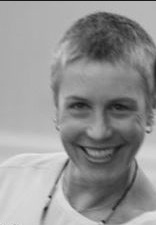
Māori researcher Fiona Cram (Fig. 2) and Hazel Phillips recently suggested a very useful way to address the obstacles created by cultural differences between Māori and Western scholars collaborating on research that addresses Māori issues [2]. They propose “the notion of interstitial space . . . as a middle ground whereby researchers can acknowledge their own worldviews and come together for fruitful transdisciplinary engagements.” To identify and meet in interstitial space, they say researchers must acknowledge their own and one another’s epistemology, ontology, worldview, and goals. And researchers have apparently been able to do this, at least to some degree, in the collaborative research teams that carry out multicultural, transdisciplinary work in and with Māori communities.

Because I think in images, I imagine the interstitial space model as looking something like the diagrams in Figures 3 and 4. In epistemology, for example, each culture has a range of methods available for its use. Each will use a certain subset of those methods in collaborative research with scientists from a second culture (Fig. 3). The area of overlap between the subset of used methods for each culture constitutes a set of methods that work within both cultures’ epistemic systems. This set establishes “interstitial space” and is the set of methods the researchers use in their collaborative work. The same basic process of acknowledging mutual cultural positions and then establishing an interstitial space for collaboration happens with ontology, worldview, and goals (Figure 4).

Fiona and Hazel’s model of interstitial space is a powerful way to think about multicultural research, one I use in this paper to analyze the possibility for interstitial space in natural sciences research. But subject matter is a crucial distinction between the social and natural sciences. Social science research is, by definition, about communities. Institutional Research Boards (IRBS) and other oversight groups can lay down guidelines that regulate the ways Western researchers work in and with Indigenous communities [3]. If researchers refuse to follow such guidelines, they are denied access to the community. Of course, just because a Western social scientist follows appropriate protocols, that doesn’t mean s/he engages Indigenous colleagues as peers or honors Indigenous research methods. That’s the primary situation Fiona and Hazel’s paper is meant to address.
But those of us in the natural sciences don’t have the leverage social scientists have when it comes to getting Western colleagues to acknowledge the cultural bases of their epistemic systems, ontology, worldview, or goals. Western scientists in biology, chemistry, physics, geology, astronomy and so on can get access to study living things, laws of matter and energy, rock formations, or stars just by securing permission from private landowners or state or federal land agencies, or from museum, observatory, and laboratory administrators; these are the people who control access to sites where natural scientists can observe and/or collect specimens or data. Indigenous communities generally have no authority over such sites. So the only reason for Western natural scientists to meet Indigenous colleagues in interstitial space is their own willingness to engage in a new practice. Of course, Western science says it wants to do just this. It tells us, “Please bring your diversity to science.” That’s why we feel so blindsided when dissertation advisors, colleagues, journal editors, lab and field supervisors, and tenure committees ruthlessly and even condescendingly edit what we do so it’s back inside the boundaries of Western research standards.
To understand why, this paper uses the model of interstitial space to analyze differences of epistemology, ontology, worldview, and goal between Western and Indigenous natural science.
EPISTEMOLOGY.

In the mid-1970s, I worked as a curatorial assistant in museum exhibits in the Museum of Natural History at the University of Kansas. One of my jobs was to care for specimens on display, including a stuffed horse named Comanche in the museum’s “American Indian” hall (Fig. 5). At that time the label on the display case still described Comanche as “the only survivor of the Battle of the Little Big Horn,” which of course he wasn’t. And that particular hall was a strange place for him to be, in a case next to a really sacred ceremonial shirt that I tried not to look at straight on. So here I was, a young Choctaw woman, and this was my job, and it was pretty weird. But that’s not why I’m telling you about it.

The important thing is that there wasn’t much of that horse there. Inside the moth-eaten, slightly threadbare skin were some of the bones – the skull and the legs, in places where the skin normally lies very close to the bone and has to have that kind of support in a mount. But the rest of the horse was wire, wood, clay, and paper (Fig. 6). That horse was kind of a tent stretched over a frame, going by the name of the horse that used to be Comanche. Its heart wasn’t there at all. Nor was the heart of what had happened at Greasy Grass — or in any of the other places represented by the exhibits on that floor.
This is an issue in every museum. You can learn a lot from fish preserved in alcohol and bird skins stuffed and stored in specimen cabinets, because they don’t run away. But they are not fish and birds any more than the mount of Comanche is a horse, and they are not kept in a sacred way that preserves any of their power (Fig. 7). In gaining the ability to make things hold still to be observed and measured, science loses the heart of the matter.
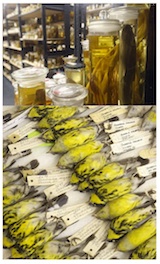
Science knows this happens. Physicist Werner Heisenberg demonstrated nearly 100 years ago that the position and the velocity of an object cannot both be measured exactly, at the same time, even in theory. Further, he wrote: “It seems to be a general law of nature that we cannot determine position and velocity simultaneously with arbitrary accuracy”[4]. You cannot extrapolate directly from the Heisenberg Uncertainty Principle to the notion that you can’t research how a bird sings in the wild and measure its exact wingspan at the same time. But it’s still true that doing one thing costs you being able to do the other thing. In gaining the ability to measure a wing, science loses the song. So, many scientists choose not to use rigid methods of testable observation, but instead use methods that seem very much like those of Indigenous science. And none of them has to fight for their colleagues’ respect over it.
Harvard paleontologist and evolutionary theorist Stephen Jay Gould (Fig. 8), president of the American Association for the Advancement of Science in 2000 [5], proudly asserted his non-use of the scientific method, saying he used a variety of methods to reconstruct a “unique and complex” history of life on earth that is ontologically non-reproducible and non-testable [6]. He insisted that a dogmatic view of anything, including scientific method, blinds innovation, writing: “Science is not a heartless pursuit of objective information. It is a creative human activity, its geniuses acting more as artists than as information processors”[7].

It’s meaningful that Gould made these and a number of similar comments in the context of a battle about epistemology that has been raging through the field of science called systematics [8] since about the time I started graduate school in the Systematics and Ecology program at KU. In fact, that’s what I was studying when I worked for Exhibits in the Museum, tending to the mounted skin of the Army horse who’d been found at Greasy Grass. Systematics is the study of how living things have diversified over time through evolution, and how they can be meaningfully grouped into categories such as “mammal” that express those evolutionary relationships. I witnessed the acrimonious energy with which this battle played out, getting first-hand experience in the intensity with which scientists often disagree about epistemology. Both sides had heavy hitters who knew their philosophy of science inside and out. The “upstart challenger” school of systematics emphasized the importance of testable and falsifiable hypotheses in scientific research, and Gould and many other prominent scientists in the established school of systematics resisted – and continue to resist – such a rigid epistemic system.
Because this particular situation developed in my own field, I knew long before I got to UC Berkeley to pursue my doctorate that science is deeply and sometimes bitterly divided about method, and that “the scientific method” is grossly oversold as “the way science is done” in public education materials. I learned a lot more about this once I got to Berkeley, where I started attending seminars on epistemic and ontologic systems of Western science, theology, and philosophy at the nearby Graduate Theological Union. A consortium of 19 seminaries and other academic organizations, GTU seminars were frequented by theoretical physicists, research chemists, astronomers, and many other scientists. It didn’t take long for me to gain familiarity with the work of other scientists who, like Gould, were outspoken about not using the scientific method in their research. So here are a few more examples of well-known scientists who used creative methods that parallel those of Indigenous research – none of them silenced the way Indigenous scientists are.

Albert Einstein (Fig. 9) “generally preferred to think in pictures, most notably his famous thought experiments, such as imagining watching lightning strikes from a moving train or experiencing gravity while inside a falling elevator. ‘I very rarely think in words at all,’ he later told a psychologist. ‘A thought came, and I may try to express it in words afterwards'”[9]. I should point out that the “words” into which Einstein put his ideas were frequently mathematical [10]. Though Einstein’s ideas often generated testable hypotheses after the fact, most were not testable at the time for technical reasons. The recent detection of gravity waves was just recently able to confirm Einstein’s theory of space-time a hundred years after he published it [11]. Does that mean the physics community did not accept Einstein’s work on space-time as valid until now? No. Because despite textbook claims to the contrary, science is not actually bound by the so-called scientific method.
Einstein’s biographer Walter Isaacson documents the ways in which Einstein grew uncomfortable in later life with the dissonance between the creative methods he’d used and his own ontologic system, which saw the world as causal and mechanical. The driving force for his discomfort, and his need to resolve the dissonance, seems to have been the rise of quantum mechanics, especially the work of Niels Bohr. The philosophical consequences of quantum mechanics on physicists’ views of ontological reality were significant then and continue to slowly play out in public awareness today [12]. The writings of theoretical physicists at the time Bohr and Einstein were discussing these matters – around 1920 — were filled with very well-read and highly-educated analyses of ontology, epistemology, causality, and other philosophical issues, and they have been ever since. So here is another powerful example of the ways in which scientists are extremely aware of the philosophical issues in their work and concerned with how those play out epistemically.

A third and fourth example of prominent scientists who used creative methods and thought critically about epistemology are James Watson and Francis Crick (Fig. 10), who discovered the structure and function of DNA – for which they won a Nobel Prize. Their research consisted primarily of manipulating a model made of tinker-toy like pieces to puzzle out the way the various atoms could be arranged in space in a structurally stable configuration. They openly copied their method from Linus Pauling (a fifth example), with whom they were racing to complete the work they were all sure would win a coveted Nobel. The final key to the puzzle was information from an X-ray crystallographic image of DNA taken by Rosalyn Franklin (Fig. 11) — whose lab supervisor, Watson explains, stole her work and gave it to Watson and Crick to help them. Watson faulted Franklin for this, explaining she was so hopelessly bound by the scientific method that she was unable to use creative methods like tinker-toy models to solve the problem. Here is how Watson wrote about Franklin’s adherence to rigid scientific method in his famous book The Double Helix:
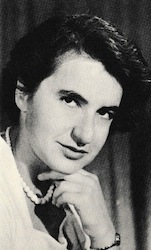
“The years of careful, unemotional crystallographic training had left their mark [on Rosalyn Franklin]. She had not had the advantage of a rigid Cambridge education only to be so foolish as to misuse it. It was downright obvious to her that the only way to establish the DNA structure was by pure crystallographic approaches. As model building did not appeal to her, at no time did she mention Pauling’s triumph over the a-helix. The idea of using tinker-toy-like models to solve biological structures was clearly a last resort. Of course Rosy knew of Linus’ success but saw no obvious reason to ape his mannerisms.” [13]
A final example is the chemist August Kekulé (Fig. 12), considered one of the most prominent theoretical chemists of the last half of the 19th century. One of Kekulé’s biggest breakthroughs was realizing that the Carbon atoms of organic compounds are attached to one other to form circular molecules rather than long chains. At an 1880 ceremony to honor his work, Kekulé credited his insight to dreams or visions he’d had while working on the problem twenty years before. In one dream he saw a snake swallowing its tail, and in the second he saw atoms dancing in a circle [14]. Scientists at the time were discomfitted by this revelation, made long before Freud or Jung began to study dream as an aspect of human psychology. (Jung was all of five years old at the time of Kekulé’s celebratory fete; Freud was 24 and had not yet graduated from medical school.)

A list of the methods used by the scientists in just these six examples gives you an idea of the real diversity of Western science’s epistemic system. It ranges from standard methods like the scientific method: testability, observation and logic, on one end; all the way through model-building, story, thought experiments, and then dream way over on the other end. This matches well enough to the methods of Indigenous science (Fig. 13) that it literally doesn’t make sense for Indigenous science students to be told “you have to use the scientific method in your research because that’s how research is done,” or for Indigenous scientists to have a problem getting their work published, being taken seriously by colleagues, or experiencing actual career sabotage.
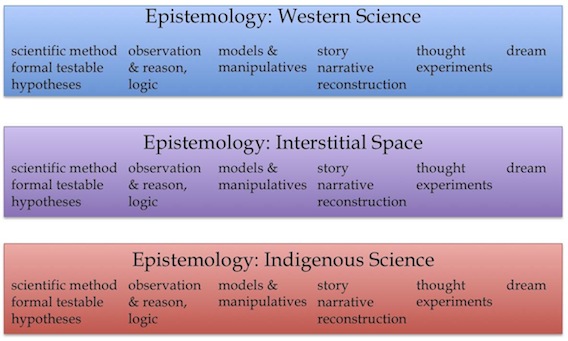
I knew about the epistemic diversity of science by the time I got to Berkeley and learned more from talking epistemology with prominent scientists at GTU seminars. That’s why when I was given a fellowship for Native students that was intended to increase diversity in the sciences, I immediately began to apply Indigenous methods to my dissertation proposal. When I was at once told in no uncertain terms that I needed to use only testable, objective observation in my work – that the scientific method was literally the only valid way of doing research – I was therefore shocked (Fig. 14). When I countered with examples like the ones I just gave you, I was told: yes, some scientists use these methods in their research, but those scientists are geniuses; the scientific method is the only appropriate epistemic system for non-genius scientists (clearly, the category to which I belonged!).
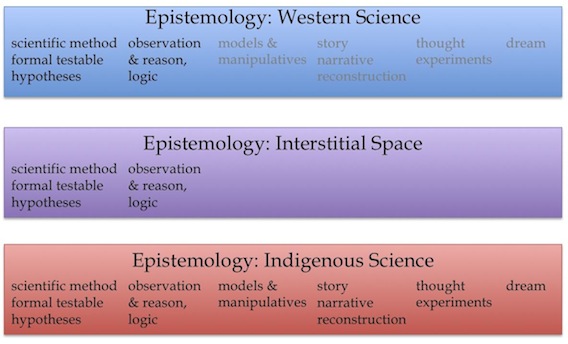
As I thought about this response, I realized there does seem to be some sort of connection between the more creative methods and genius in Western science. Einstein was a genius. Watson and Crick copied their modeling system after Linus Pauling and Watson wrote “only a genius of his stature could play [with tinker-toys] like a ten-year-old boy and still get the right answer” [15]. Gould said it’s geniuses who do science as an art. And I wondered if it wasn’t that it was geniuses who could use these methods . . . but if it was using these methods that was so brilliant — if the methods were what powered the big breakthroughs. But that insight just made the situation more puzzling, because you’d think scientists would be all over themselves trying to copy the methods of brilliant and successful scientists.
Over the years as I’ve continued to struggle with this issue, I’ve realized it can’t be resolved at the level of epistemology because it isn’t really about epistemology itself. It’s rooted in, and about, the ontological view of reality that is the foundation of cultural epistemic systems.
ONTOLOGY.

Generational trauma interests a lot of Indigenous people (for obvious reasons), so it provides a useful vehicle for exploring the ontology of Western science. The way generational trauma works is basically this: A person experiences trauma, which causes neurons and other cells in the body of the traumatized person to produce certain biochemicals. Those biochemicals trigger a whole cascade of effects in the body, the way one thing leads to another in that old “mousetrap” game. At some point the chain reaction causes a molecule made of one carbon and three hydrogen atoms — CH3, which is called a methyl group – to attach itself to the nearest DNA molecule. Such DNA is then said to be methylated (Fig. 15). Of course, many methyl groups are produced at the same time when this kind of thing is happening, so many DNA strands in many cells wind up with methyl groups attached to them after a traumatic event.
Normally, DNA is copied by RNA, which carries the DNA’s information out of the nucleus and into the rest of the cell. There, this information is used to build proteins, enzymes, hormones, and all the things that make up a body’s structure and carry out its functions (Fig. 16). But if there is a methyl group glommed onto a DNA molecule, that part cannot be copied by the RNA; it’s blocked. The proteins, enzymes, or whatever should be manufactured from that part of the DNA cannot be made. So it’s said the gene that piece of DNA carries the blueprint for has been “turned off.” If genes we need are turned off and we cannot make the things our bodies need to function properly, the result can range from depression and anxiety to cancer or heart disease. If the genes that get turned off happen to be in an egg or sperm cell, any baby that grows from them will inherit a methylated DNA strand with a turned-off gene. So then the effect of the trauma gets inherited [16].
The idea that all human structures and functions are produced by molecules that are manufactured inside cells, by copying the instructions coded into DNA, is a foundational concept in biology. It’s called, for real, The Central Dogma. The Central Dogma draws an arrow of control from DNA, to RNA, to the production of every molecule responsible for body, brain, emotion, creativity, language – everything a human is capable of doing or being [17]. The Central Dogma, indeed science itself, sees all these things as determined by genes. The Central Dogma is therefore materialistic, seeing life as entirely of matter. Even language, creativity, and consciousness are seen as biochemical and biophysical processes acting on the molecules of cells. The Central Dogma is also reductionist, which means it sees big things like consciousness as the product of processes that occur at the level of atoms and molecules.
Epigenetics doesn’t change anything about the Central Dogma. It simply adds a little extra onramp into the system (Fig. 17). Epigenetics explains how an external stimulus – something outside a body — can cause changes inside the body, in the DNA. The mechanism is that chain-reaction sequence of biochemicals I described in the first paragraph of this section. So epigenetics is still about matter, cells, and molecules. It is still materialistic and reductionistic.
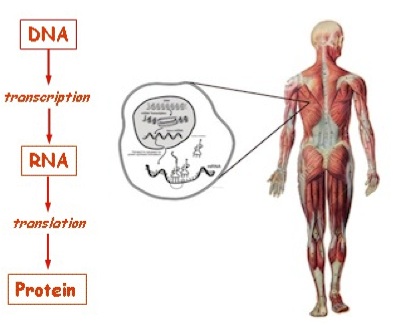
The Central Dogma predates Watson and Crick’s discernment of DNA’s structure and function. In a famous series of lectures called “What is Life?” in 1943 [18], physicist Ernest Schrödinger argued that life is reducible to the atomic components of genetic transmission and the physico-chemical laws that govern them. Schrödinger based his argument on the philosophical principles of materialism and reductionism, which posit that every aspect of life – human as well as non-human; physical development, physiological function, behavior, emotion, creativity, language, and culture — have to be found in the cells and only the cells. Materialism leaves no room for an alternative. Cells are the material make-up of living things so life processes have to be in the cells. As we now know, cells are what have DNA in them, cells actually do the manufacturing of proteins, enzymes, and other biochemicals, cells transmit chemical and electrical signals, and so on.
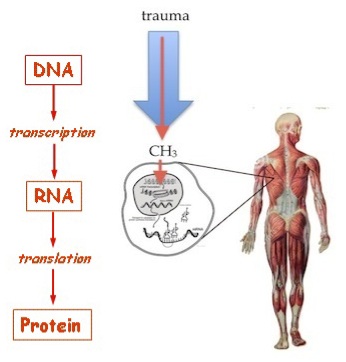
The Central Dogma is therefore based on an even more foundational idea in biology, called the Cell Theory. The Cell Theory states that all cells come from pre-existing cells, that all living things are made of cells, and that all the functions and actions of living organisms are explainable in terms of cell structure and function. Because the Cell Theory is the foundation of The Central Dogma, it is also the foundation of Epigenetics. That means the whole idea of generational trauma, which is in many ways gratifying to us, exists completely within the notion that every living thing is made of cells and that all the functions and actions of living organisms are explainable in terms of cell structure and function. This is a strong expression of Western science’s ontology. How does it compare to Indigenous ontology?
Let me ask you some questions.
Q: If everything living thing is made of cells, then is a stone alive?
A. No. Because stones are not made of cells.
This conclusion is, of course, generates a troubling problem for most Indigenous people. It conflicts with generally-accepted Indigenous ontology.
Going further:
Q: If the physical and chemical processes that take place in cells under the control of genes are responsible for behavior, intelligence, and language, as stated by the Central Dogma and its materialistic and reductionist premises, then is it possible for a mountain or a stone, which do not have cells, to communicate information to someone?
A. No. It is not.
This is an equally unacceptable conclusion for most Indigenous people.
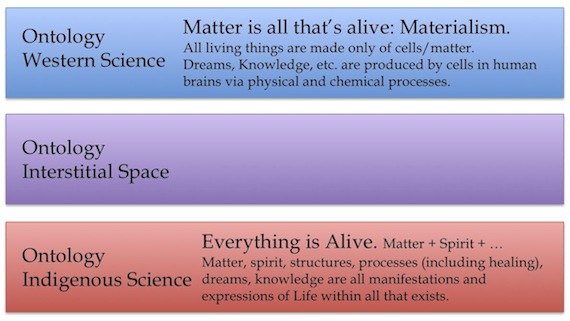
Crashing head-on into the ontological difference between Western and Indigenous science helps us truly understand that Western science sees reality as material, and sees its processes as reducible to atomic structure and the physical and chemical processes that take place at that level. It helps us fully understand that Western science sees all the structures and functions of living beings, including human thought, language, and creativity, as likewise produced by these physical and chemical processes inside the material cells that make up the body (Fig. 18). As a result, Western science sees living things as completely separated from everything around them, with a very strong barrier between “inside” and “outside.” Every thought a person has, every dream, every vision comes from inside that person’s own body.
As a result, Western culture sees knowledge as created by human beings. Every academic publication begins with a review of all relevant previous work, author by cited author, because research necessarily builds upon the pieces of knowledge previously constructed by one’s predecessors. Further, knowledge inherently progresses as more scholars build an ever-higher tower of information. This is why Isaac Newton said, “If I have seen further, it is by standing on the shoulders of Giants” [19].
The inside/outside barrier in Western science also explains why epigenetics is a big deal in science itself: it outlines a physical, mechanical, material mechanism by which events outside the body can come inside and alter it. But the process is still materialistic and reductionist. Of course, there is no “inside/outside” barrier in the ontologic system of Indigenous science as it’s generally described. Indigenous ontological reality is that everything – including stones, I add emphatically — is alive, and that everything — including humans — is in deeply connected relationship to everything else.
Before I go on, I want to come back to generational trauma, because the idea itself has been so important to many of us. It’s gratifying to be able, at least in some way, to feel that our sense of how historical trauma continues to impact our lives today is justified by science. It’s hard to give that up. That may be why the most common response I see when people first realize the entire idea of generational trauma is materialistic and reductionist is: “But look! This actually allows us to explain why our healing rituals work! The stones, tobacco, and other things in our healing ceremonies must de-methylate DNA!” But . . . if you say a sacred stone effected the healing in your ritual, how is that possible if the stone is not alive? Remember, that is the only “true” statement about stones possible in that ontologic system. So you are left with only a placebo effect: that your perception of the non-living stone as alive triggered biochemical changes in you that de-methylated your DNA. That is the only mechanism by which this could happen that fits the premises and philosophies of the theory of generational trauma, Epigenetics, and the Central Dogma. Maybe you are comfortable with that. I’m not. Stones are alive. And this is essential to remember. It matters.
On the other hand, the processes of generational trauma can be PART of how sickness and healing happen – just not ALL of it. In Indigenous worldview, the dualism of “either/or” is not a necessary philosophical position, and we need to not let Western culture somehow convince us that it is. Yet, while the theory of generational trauma helps us understand what we’re up against, at the same time we have to be very careful to remember that it’s not the whole story. Our futures are not hopelessly bound in the absence of a material cure for DNA methylation. Healing rituals work, and they work because of the actions of our living relations who are animals, plants, waters, stones, spirits, and stories. As Indigenous people, we have knowledge and ways that give us the power to bypass material mechanisms and free ourselves and our children from the impact of trauma. We must not let the restricted, materialist, reductionist, dualistic either/or worldview of Western culture bind us the way it has bound them.
Now, let’s circle back and consider how the difference in Western and Indigenous ontology impacts method. In Western science, if a chemist has a dream that solves a problem, it’s because his subconscious mind was biochemically processing the data while he slept. The automatic program that produced a solution simply finished running during the sleep state instead of the waking state. Kekulé, for instance, suggested his dreams or visions of carbon molecules were the natural outcome of working on the problem for so many years.
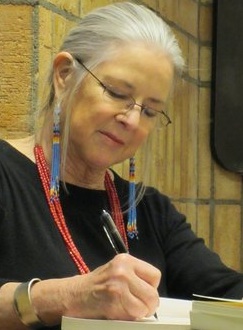
In contrast, Chickasaw Linda Hogan (Fig. 19) wrote in Solar Storms, one of my favorite of her books: “But there was a place inside the human that spoke with land, that entered dreaming, in the way that people in the north found direction in their dreams. They dreamed charts of land and currents of water. They dreamed where food animals lived. These dreams they called hunger maps and when they followed those maps, they found their prey. It was the language animals and humans had in common. People found their cures in the same way” [20].
So if we include ontology with epistemology by “stacking” them in our diagram so epistemology is “on top” with ontology as its base, we can see that dream — as a method of acquiring information in Indigenous epistemic systems — IS NOT the same, ontologically, as dream as a method of acquiring information in the Western science epistemic system (Fig. 20). We Native people are pretty clear about our ontology and where we think the knowledge in dreams and our other “creative” research methods comes from. Science pays attention to that. So now we start to see why science restricts our methods: it’s because of ontological differences that change how we each see these methods.
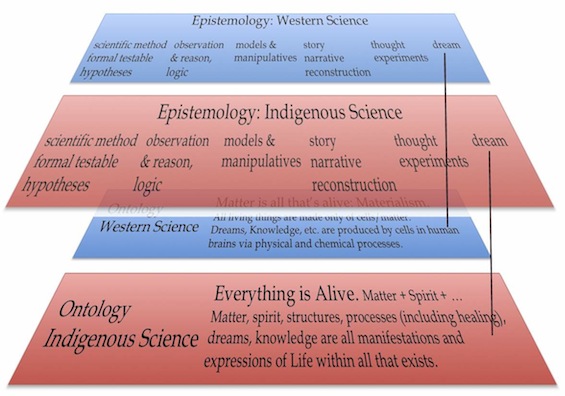
Let me give you two examples that illustrate how very tenuous it is for even a Western scientist to use methods that seem to violate Western science’s ontologic system of “knowledge comes from within the brain.”

Barbara McClintock’s work on corn genetics led to a Nobel Prize in 1983, when she was nearly 80 years old (Fig. 21). Most of the innovative research for which she was awarded this prize was done in the 1940s and early 1950s, but met with such skepticism in the scientific community that she shifted the focus of her research. It wasn’t until nearly two decades had passed that the larger scientific community finally understood and accepted her work. In interviews given to Evelyn Fox Keller for a biography published the year following her Nobel award, the words McClintock uses to describe her work are very much in line with Indigenous research methods: they’re about relationship. “Over and over again she tells us one must have the time to look, the patience to ‘hear what the material has to say to you,’ the openness to ‘let it come to you.’ Above all, one must have ‘a feeling for the organism” [24]. Interestingly, Keller writes that McClintock hid these methods for most of her career. She said it was only the validation provided by the Nobel that created enough credibility for her to talk about them openly.
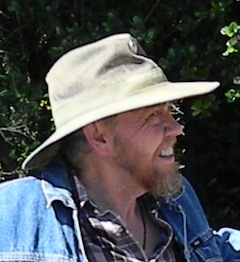
Scientists who are not Nobel laureates also use methods that seem to lie outside the Western ontological system of “knowledge comes only from within the human’s own brain.” Jane Robinson, now James Robinson (Fig. 22), a vertebrate paleontologist who specialized in biomechanics (and now works by choice in a different profession that utilizes his biomechanics expertise), realized the limbs of plesiosaurs functioned as flexible underwater wings or hydrofoils even though the unquestioned view for over a century had been to see them functioning as rigid oval-shaped oars (Fig. 23). My Master’s thesis in 1977 described a fossil specimen in which one of the fins displayed the perfectly preserved hydrofoil shape that verified the mode of swimming Jane had predicted [25]. Here’s Jim’s backstory on the whole thing:
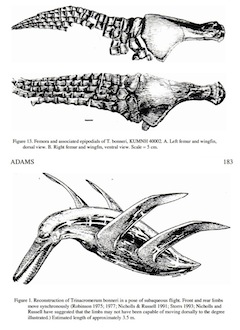
“I was doing a pre-doc at the University of Tuebingen in Germany, living in my office at the museum and sleeping on a Volkswagen bus seat because they weren’t paying me very much at all. There was a wonderful Plesiosursaal with two free-mounted specimens and several slabs, one from Holzmaden, on the walls. When I couldn’t sleep, which was often, I would take a chair into that room and just sit and contemplate my ancient friends in the half-lighting that made them seem almost magical. One night I dozed off in my chair and dreamed that I was a swimming pliosaur, feeling my body maneuver through the water using all four “wings,” my body, neck and tail. What a marvel of proprioceptive complexity! I woke up breathless, wondering how I was going to turn this experience into science. Fortunately, I’m pretty good at translating what I know into acceptable scientific (and now medical) terminology, deflecting as necessary any questions about how I know it.”[26]
Western scientists who use methods that really do fall close to or within Indigenous epistemology and ontology do not feel they can openly discuss those methods in the scientific community. At some level, the same is true for Indigenous scientists who use these methods, as we’ve seen with Margaret Hiza’s work. But we Indigenous scientists must acknowledge the methods we use; we can’t hide them if we have cultural integrity. At any rate, this is a second reason science resists most Indigenous research methods, and tells us the scientific method has always been part of our peoples’ ways. And since observation and trial-and-error testing is something we seem to have in common, that seems pretty safe.
I have a story about that [27].
Some young Native men were not doing so good with their elk hunts any more. They decided they’d be more successful if they got rid of their rifles and ATVs and did things the old way.
So they started running to get their stamina up. They learned to make strong bows and straight arrows. They practiced shooting until they could put an arrow all the way through a target at a dead run. They became superb trackers and learned to slip through the forest in absolute silence. When it came time to hunt elk again, they were feeling pretty good about themselves. They took their bows and arrows and went into the forest.
But they didn’t see a single elk. Not even sign.
So they took some tobacco and went to the house of a local Elder who was known to be the best elk hunter in the community. They asked if he would come hunting with them the next day. They figured they must be doing something wrong that he could show them. The Elder agreed to go. But the next day they waited a long time at the rendezvous spot, and he did not show up. So they asked him a second time. And a second time they waited for hours by the tall tree where he’d told them to wait, and he did not meet them. So they asked him a third time, to show they were really serious about it all. And this time he told them to come to his house tomorrow.
The next morning before sunup the young men waited outside his door with their bows and their arrows, eager as pups watching a kettle. The sun cleared the trees, and still the old man slept. They could hear him snoring. Finally, mid-morning, he came stumbling out with his hair going every which-way and sleep in his eyes, and an old rusty rifle in his hands that looked like it might not even fire any more. “All right,” he said, “Let’s go get some food for the people.” And off he went, stumbling and crashing through the woods, tripping over roots and banging into trees. The young men shook their heads and asked themselves what on earth they were ever going to learn from this guy. Clearly he’d forgotten anything he ever knew, and lost any skills he ever had. He could hardly even get through the forest in once piece.
But then they came into a clearing where an entire herd of elk had just been grazing. They’d heard the men coming and were already turning to run away. The young men whipped arrows from their quivers and started to run in pursuit.
But the Elder said, “Stop. Wait.”
The young men stopped. They turned to face him. He was an Elder, after all. They could hear the elk running through the trees, getting away.
“Help me get up on this rock,” said the old man.
The young men looked at each other. They shrugged and went to the old man. They helped him clamber up on top of a big rock at the edge of the clearing. The forest was silent now, not even a jay calling.
The Elder started to sing. His voice rang through the forest, thin like an old man’s voice, but strong the way a wind is strong. The herd reappeared, dark and slipping through the shadows. They paused at the edge of the trees. Then the women elk pushed three young bulls into the clearing. They came into the sunlight and stood silent, very still. The Elder shot two of them with his ancient rifle – one shot, a second shot. Then he thanked the elk for offering themselves and climbed down off the rock.

In Spirit and Reason, Lakota scholar Vine Deloria (Fig. 24) wrote about the difference between rifles, arrows, and songs this way: “We have reduced our knowledge of the world and the possibility of understanding and relating environment to a wholly mechanical process. We have become dependent, ultimately, on this one quarter of human experience, which is to reduce all human experience to a cause-and-effect situation. As Indians look out at the environment and as Indians experience a living universe, relationships become the dominating theme of life and the dominating motif for whatever technological or quasi-scientific approach Indian people have to the land. Indians do not simply learn survival skills or different ways to shape human utensils out of other natural things. In shaping those things, people have the responsibility to help complete their life cycles as part of the universe in the same way they are helping people. Human beings are not above nature or above the rest of the world. Every species needs to give to every other species in order to make up a universe” [28].
In calling tool-making and survival skills technological and quasi-scientific practices of Indigenous peoples, Deloria is saying: yes, these practices have gross similarities to “the scientific method”– but this is not the part that matters. Relationship to a living world is the dominant motif of Indigenous worldview, and Deloria is saying that all the things we do that parallel the scientific method are done within that context of relationship — which fundamentally changes their meaning and power. Further, he’s saying that to see these things as somehow proving our people have always engaged in the scientific method reduces the core of who we are to a paltry one-fourth of what it is, always has been, and should remain for the sake of future generations who need its power.
After all, the elk did not appear simply because the young men used arrows instead of guns. They showed up when the man who knew the song came into the forest.
It’s not just our dreams that are ontologically different from Western dreams. Our observations — participatory and relational — are ontologically different from the objective, separated observations of Western science (Fig. 25). The reality out of which we operate changes everything.
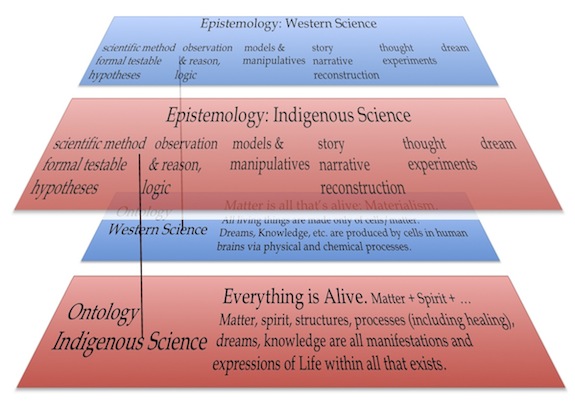
Science tells Indigenous people our methods of art, story, dream, intution, and spiritual insight are not really the same as methods with the same names that are used by Western Nobel laureates. It therefore rules these methods off-limits to us. It tells us that our methods of observation and trial-and-error experimentation are the same as those of Western science, however, and that therefore we can (and should) use them just like our ancestors “always have.” In this case, it is up to us to tell science that those methods are also not the same in our two cultures. Our ontologic view of reality impacts observation and trial-and-error experimentation just as much as it impacts ways of learning such as story, art, dream, and spiritual insight.
Our research methods have the same names, but they are not the same things at all.
GOALS.
There is one area left for us to consider in Fiona and Hazel’s model of interstitial space: goals. There are several common goals for research in Western culture:
- the pleasure of learning
- acquiring knowledge to benefit people and/or the natural world
- acquiring personal power that can lead to greater ease of publication, more grant funds, public and political authority, and prizes such as the Nobel
- making money for one’s self or corporate stockholders (especially through the technological application of scientific information)
- acquiring knowledge that confers power in policy-making decisions about how natural resources are handled, how children are educated, what medical research is pursued
- acquiring knowledge that confers competitive advantage to a given society and/or geopolitical nation in the world community
The second goal, of doing research to acquire knowledge that can benefit people (in particular) is a goal I suspect most people in social sciences serve. It may be that this common goal is what facilitates multicultural collaboration between Māori and Western researchers, creating a significant common ground that overcomes other differences and allows participants to establish interstitial space. Most natural scientists in “pure research” (as opposed to “applied research”), do it for the pleasure and excitement of learning, though a significant number of research scientists serve goals related to social policies. In doing so, of course, they see themselves as working to benefit people and/or the natural world as well.
But the last goal I’ve listed is the most important to this discussion, as it’s the stated goal of the National Science Foundation. It’s important because NSF funds a great deal of Indigenous science education and research. When it partners with Indigenous science, the goals that occupy the interstitial space are relevant to our ability to truly collaborate.
NSF’s goals are clearly and openly published: NSF is “an independent federal agency created by Congress in 1950 ‘to promote the progress of science; to advance the national health, prosperity, and welfare; to secure the national defense…’”[29] The government set NSF up to serve these goals because science played such an essential role in America’s WWII victory, primarily through the Manhattan Project. In fact, people from four different disciplines worked together to produce the bomb that won the war: science, technology, engineering, and mathematics — and they’ve been together in NSF ever since as STEM [30].
There is nothing inherently wrong or sinister about NSF having the goals it has. The question is whether or not, and how, Indigenous researchers might find interstitial space with an organization holding such goals. With respect to NSF’s “Indigenous science education” efforts for Indigenous people in natural science careers, the Foundation’s most recent Strategic Plan states: “The global competitiveness of the United States in the 21st century depends directly on the readiness of the Nation’s STEM workforce. Educational institutions around the country must recruit, train, and prepare a diverse STEM workforce to advance the frontiers of science and participate in the U.S. technology-based economy” [31]. The goal of “global competitiveness of the United States” is clearly present in that statement.
In reading the documents that pertain to NSF’s work with Indigenous people, it seems clear the Foundation’s goals are the goals for the collaborative projects themselves. In other words, there is no negotiated interstitial space for goals. Here are two examples that show clear statments of NSF’s goals being THE goals for its multicultural work in Indigenous science education:
1. In an October 3, 2016 news article titled “Scientists calling for True Diversity in STEM at SACNAS Conference,” the SACNAS Executive Director is quoted as saying: “To maintain a globally competitive STEM workforce, we need to achieve true diversity in STEM” [32]. (SACNAS is the Society for Advancement of Chicanos/Hispanics and Native Americans in Science.)
2. In a story dated late September of this year about an NSF grant to Northern Michigan University to increase the numbers of Native women in science, the last paragraph is from a press release that quotes NSF’s Director: “For more than six decades, NSF has funded the development of STEM talent, with the goals of furthering scientific discovery and ensuring the nation’s security, economy and ability to innovate,” said NSF Director France Córdova in a press release. “I’m gratified to see such a strong start to the [NSF INCLUDES] program, which we hope will be an enduring investment in our nation’s future in scientific discovery and technological innovation” [33].
NSF is funded by the American government and is accountable to the American people through Congressional oversight. It serves the goals created for it at its inception, and program officers must be able to justify their portfolios according to NSF’s strategic plan and those specifically stated goals. It can certainly be argued that the funder for any enterprise — whether in science, art, or business – “gets to” determine the funded project’s goals. Funding is in fact often awarded based on a perceived similarity of goals with those of the funding agency. So in itself, there is nothing problematic about NSF’s goals being the de facto goals for the multicultural work it funds in Indigenous science.
The question is: Are these the goals of Indigenous scientists who use Indigenous research methods in their work?
After talking with many Indigenous scientists, and thinking of my own life, it seems the answer is “no.” Our goals are frequently along the lines of: “to help my community” or “to give back to my people.” It is also important that many Indigenous research graduate students tell me they do what they do because the spirits and ancestors are urging them do this kind of work right now because it’s about to be very important to all of us.
These are good goals. They are goals that give us the strength to keep going even when we keep hitting obstacles so hard that we get smashed into splinters. They help us get up, find a way around the obstacle, and get back on the trail – over and over and over again. THIS is the power of Indigenous spirit. And I hate to see that spirit piled up so painfully against the obstacles of Western science’s inflexible methods in the service of goals that are incompatible with our own.
We need to put the strength of the spirit in our Indigenous graduate students to better use.
THE WAY AHEAD.
We all know the earth is in serious trouble. Sustainability is not about simply taking less. Sustainability is about living in mutual relationship so that the Elder’s people and the elk’s both thrive because of each other’s sacred actions and the song that binds them together. We understand that. Western culture does not. Reclaiming, restoring, preserving, protecting, and healing our relationship with the living land is essential for the survival of anything that’s going to make it through the process of destruction that has already started. We need the deer, the salmon, the beaver, the corn, the prairie dog, the mantis, the wren. And they also need us.
I think Indigenous scientists are potentially like the Elder who knows the elk song. Ed Galindo of the University of Idaho, who removes beavers from untenable locations and rehomes them in safe zones, is likely in relationship with the Beaver people he rescues. I think Jane Mt. Pleasant, at Cornell University, is in relationship with Corn. For myself, I’ve integrated my knowledge of geology with Indigenous knowledge to find sacred places people don’t remember any more. I do ritual for them. They need it.
I think we Indigenous researchers in the natural sciences serve the Land.
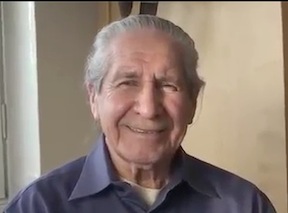
But you know, there’s that worry everyone has about “What happens when we lose the Elder who knows the song of relationship with the deer?” Seneca leader Oren Lyons (Fig. 26) says “When we lose an Elder who carries a great deal of traditional knowledge, people say it’s gone: ’When she died, we lost it.’” Then he explains, “It’s not lost. It’s still there. It’s not lost at all.” [34]
The information passed down through the Elders, the songs and rituals and words — where did all that come from to begin with? It came from the Land. And the Land is still here. We can learn those things again for ourselves. And we need to, because the land is changing right under our feet because of climate change. The land’s got to give us a lot of new information, very quickly, and we’ve got to learn how to hear, how to understand, how to assess, how to test, and how to apply it. And why do I think we can do that? Because we’re Indigenous scientists! For cryin’ out loud! We were born to figure this out hand in hand with the Land!
Linda Hogan again, from Solar Storms:
“I was devoted to woods the wind walked through, to mosses and lichens. Somewhere in my past, I had lost the knowing of this opening light of life, the taking up of minerals from dark ground, the magnitude of thickets and brush. Now I found it once again. Sleep changed me. I remembered things I’d forgotten, how a hundred years ago leaves reached toward sunlight, plants bent into currents of water. Something persistent nudged me and it had morning rain on its leaves. . . Maybe the roots of dreaming are in the soil of dailiness, or in the heart, or in another place without words, but when they come together and grow, they are like the seeds of hydrogen and the seeds of oxygen that together create ocean, lake, and ice. In this way, the plants and I joined each other. They entangled me in their stems and vines and it was a beautiful entanglement” [35].
Starla Bilyeu, Eastern Cherokee and founder of Academic Transitions, recently reminded me of the words of Cherokee chief Wilma Mankiller: “Every step I take forward is on a path paved by strong Indian women before me.” The path I am describing to you is the path our ancestors walked. But they walked it in a time of less serious challenge to the survival of everything, and they had more time than we do to figure things out. We need a new generation of Indigenous scientists to serve the Land – which serves everything, including our people. What we’re doing in AIRA matters a great deal. And it matters that we do it Indigenous. We also need a new kind of foundation that has the goal of serving the Land, that awards research funding to Indigenous scientists engaged in this goal of serving the Land, that secures endowments to support this kind of research from donors who are committed to serving that goal, and that operates within Indigenous worldview.**
“. . . it is not that the ways are lost from us but that we are lost from them. But the ways are patient and await our return.” [36]
Let us return – and go forward — together.
Yakoke.
——————————————–
NOTES AND CITATIONS
* Original url was http://tapestryinstitute.org/occasional-papers/in-service-to-the-landindigenous-research-methods-in-the-natural-sciences-vol-2-no-1b-october-2016. That link now redirects to this page.
**Tapestry Institute took the first steps of establishing such a Foundation in 2019, with the IKhana Fund program.
[1] Margaret Hiza Redsteer, personal communication, June 3, 2016. To see how Margaret uses narrative data in her research, see: Redsteer, M.H, Bogle, R.C., and Vogel, J.M., 2011, Monitoring and analysis of sand dune movement and growth on the Navajo Nation, southwestern United States: U.S. Geological Survey Fact Sheet 2011–3085, 2 p., available at http://pubs.usgs.gov/fs/2011/3085; and see also: Assessment of Climate Change in the Southwest United States. A Report Prepared for the National Climate Assessment. NCA Regional Input Reports. Angela Jardine, Robert Merideth, Mary Black, and Sarah LeRoy; Edited by Gregg Garfin. 528 pages. Washington, D.C.:Island Press
[2] Fiona Cram and Hazel Phillips. 2012. Claiming interstitial space for multicultural, transdisciplinary research through community-up values. International Journal of Critical Indigenous Studies, 5 (2), p. 36
[3] See, for example, “Researcher Guide” a webpage of resources for researchers provided by the First Nations Health Authority, at http://www.fnha.ca/what-we-do/research-knowledge-exchange-and-evaluation/researcher-guides
[4] Werner Heisenberg. 1927. “Über die Grundprincipien der Quantenmechanik” (“On the fundamental principles of quantum mechanics”). Forschungen und Fortschritte, 3: 83. (Italic emphasis in occasional paper text added by author.) For more information, see: Hilgevoord, Jan and Uffink, Jos, “The Uncertainty Principle”, The Stanford Encyclopedia of Philosophy (Winter 2016 Edition), Edward N. Zalta (ed.), forthcoming URL = <http://plato.stanford.edu/archives/win2016/entries/qt-uncertainty/>.
[5] A bibliography of Stephen Jay Gould’s books is available on this website: http://www.stephenjaygould.org/bibliography.html. Accessed September 25, 2016.
[6] Stephen Jay Gould. 1980. The Panda’s Thumb: More Reflections in Natural History. W.W. Norton & Company, New York. p. 18-27
[7] BBC News. “Acclaimed science writer dies” (obituary for Stephen Jay Gould). May 21, 2002. Available at http://news.bbc.co.uk/2/hi/science/nature/1999341.stm. Accessed October 5, 2016.
[8] If you are interested in learning more about the specifics of how epistemology and the scientific method are vigorously and even acrimoniously debated in at least one field of the natural sciences, the following books provide an excellent analysis: (a) Science as a Process: An Evolutionary Account of the Social and Conceptual Development of Science. David L. Hull. University of Chicago Press. Chicago. 1988 586 pp. David Hull was a philosopher of science who chronicled the battle about epistemology in the field of systematics. He became so conversant with the situation, and so deeply accepted, that he was elected president of the Society of Systematic Zoology (the primary professional organization of systematists; he also served as president of the Philosophy of Science Association) during this time period. (b) The Evolution of Phylogenetic Systematics. Andrew Hamilton, Ed. University of California Press: Berkeley and Los Angeles. 2015. Contributors include key players from Hull’s day: Hamilton, Gareth Nelson (University of Melbourne), Olivier Rieppel (The Field Museum), Norm McLeod (Natural History Museum, London). This recent book brings interested students of applied epistemology in one field of science, systematics, up to date on what has changed since Hull’s day. It will become immediately clear that though the school referred to as cladistics has “won” a lot of ground – many museum exhibits are being redesigned using cladistics organizational schemes and terms – the controversy is far from over and the issues have not changed.
[9] Walter Isaacson. 2007. Einstein: His Life and Universe, NY: Simon & Schuster. Quoted passage appears in Reference 4 for Chapter 2: “Childhood”. It cites material from “Vallentin, 17; Einstein to psychologist Max. Wertheimer in Wertheimer, 1959, Productive Thinking, NY Harper: 214. Antonina Vallentin. 1954. The Drama of Albert Einstein. NY Doubleday.”
[10] Mathematics is more a language than anything else to which it can be compared by non-mathematicians. “Competing” equations that describe the same phenomenon in different ways are frequently evaluated aesthetically. See, for example, Melissa Hogenboom. 2016. “You decide: What is the most beautiful equation?” BBC Earth. Available at http://www.bbc.com/earth/story/20160120-you-decide-what-is-the-most-beautiful-equation-ever-written. Accessed Feb. 9, 2016. The most important supporting statements about how mathematicians and theoretical physicists see mathematics are in the text on pages linked to each of the equations.
[11] “Gravitational Waves Detected 100 Years After Einstein’s Prediction.” February 11, 2016. LIGO Hanford Press Release. (LIGO is Laser Interferometer Gravitational-Wave Observatory.) Available at https://www.ligo.caltech.edu/news/ligo20160211. Accessed October 15, 2016. NOTE: It is interesting, in this context, that politics played a big role in both the awarding of a Nobel to Einstein and also the non-awarding of one to him for many years before the 1921 committee gave him one because “none of the year’s nominations met the criteria as outlined in the will of Alfred Nobel” (“The Nobel Prize in Physics 1921” Webpage of The Official Website of the Nobel Prize. http://www.nobelprize.org/nobel_prizes/physics/laureates/1921). Although the standard explanation for community resistance to awarding a Nobel to Einstein before 1919 focused on the fact that relativity had never been verified by testing (it finally was, in 1919 — but his Nobel was not awarded for his work in relativity anyway, as it happened), many science historians rack the resistance up to strong anti-Semitism at the time. (See, for example, lengthy passages in the Walter Isaacson biography, Op. cit.; see also Stuart Clark. “Why Einstein never received a Nobel Prize for relativity.” The Guardian. https://www.theguardian.com/science/across-the-universe/2012/oct/08/einstein-nobel-prize-relativity). Perhaps the take-home point here is that even Einstein was not immune to prejudice against people outside the dominant culture, or to the use of “the scientific method” as a lever to suppress the work of “outsider” scientists.
[12] See, for example, Isaacson. Op. cit., pages 334-350.
[13] James D. Watson. 1968. The Double Helix: A Personal Account of the Discovery of the Structure of DNA. NY: Atheneum. 226 pages.
[14] See, for example, the well-done page “August Kekulé” page at Wikipedia.com. available at https://en.wikipedia.org/wiki/August_Kekul%C3%A9. Accessed October 17, 2016.
[15] Watson, Op. cit., p. 69.
[16] For more information about epigenetic mechanism, select from this range of explanatory texts: (a) Sally Robertson. 2015. “What is DNA Methylation?” Posted Sept. 17, 2015 on the Medical and Life Sciences News website. Available at http://www.news-medical.net/life-sciences/What-is-DNA-Methylation.aspx. Accessed October 16, 2016. (b) Bob Weinhold. 2006. “Epigenetics: The Science of Change.” 2006. Environmental Health Perspectives, vol. 114, No. 3. pp. A160-A167. Published by the National Institute of Environmental Health Sciences, a division of the National Institutes of Health (NIH). (c) Tania L. Roth. 2014. How traumatic experiences leave their signature on the genome: an overview of epigenetic pathways. Frontiers in Psychiatry, Vol. 5, Art. 93, pp. 1-2. (d) Samar Zakhari. (no date provided) Alcohol metabolism and epigenetics changes. Alcohol Research: Current Reviews, Vol. 35, No. 1. Available at http://pubs.niaaa.nih.gov/publications/arcr351/6-16.htm. Accessed October 1, 2016.
[17] See for example, “Central Dogma of Biology: Classic View,” Webpage at NCBI (National Center for Biotechnology), part of the National Institutes of Health. Illustration adapted from the National Human Genome Research Institute (NHGRI) Genetic Illustrations entry for mRNA. Available at http://www.ncbi.nlm.nih.gov/Class/MLACourse/Modules/MolBioReview/central_dogma.html. Accessed July 10, 2016.
[18] What is Life: The Physical Aspect of the Living Cell. Erwin Schrödinger. Based on lectures delivered under the auspices of the Institute at Trinity College, Dublin, in February 1943. Cambridge University Press. 1962. London. 92 pp. Note: On the 50-year anniversary of Schrödinger’s series of talks, a new convocation of scientists met to discuss the ways in which biology is moving in new, non-reductionist directions. Edited by Michael P. Murphy and Luke A. J. O’Neill and published in 1995 (NY: Cambridge University Press), What is Life? The Next Fifty Years: Speculations on the Future of Biology presents papers by scientists and mathematicians who are leaders in the study of stochastic events, non-deterministic probability, and self-organizing complexity. Any student of the life sciences would be well-advised to study the leading-edge thought and research in this little book.
[19] Isaac Newton. Letter to scientist Robert Hooke, Feb. 15, 1676.
[20] Linda Hogan. 1995. Solar Storms. NY: Scribner, pp. 170-171.
[21] “Vatican admits Galileo was right.” New Scientist, no. 1846. 1992. Available at https://www.newscientist.com/article/mg13618460-600-vatican-admits-galileo-was-right. Accessed October 10, 2016.
[22] See “Chapter 7. Patterson’s Curse, Molecular Homology, and the Data Matrix” by David M. Williams and Malte C. Ebach, in The Evolution of Phylogenetic Systematics. Andrew Hamilton, Ed. University of California Press: Berkeley and Los Angeles. 2015.
[23] https://twitter.com/neiltyson/status/748157273789300736
[24] Evelyn Fox Keller. A Feeling for the Organism: The Life and Work of Barbara McClintock. 1984. Times Books.
[25] Dawn Adams. 1997. Trinacromerum bonneri, new species, last and fastest pliosaur of the Western Interior Seaway. Texas J. Sci., 49(3):179-198.
[26] Jane A. Robinson, Ph.D. (now James D. Robinson, Ph.D.), pers comm 6.14.16.
[27] This story was shared with me, and I was told I could share it in this paper with you as I have. The original teller approved this version and asked that I not “credit” him, as he saw no need in this situation.
[28] Vine Deloria, Jr. 1999. Spirit & Reason: The Vine Deloria, Jr., Reader. Edited by Barbara Deloria, Kristin Foehner, and Sam Scinta. Fulcrum Publishing Co., Golden, CO, p. 225-226. (Italics in the passage added by the author.)
[29] “NSF at a Glance.” Webpage of the National Science Foundation. Available at https://www.nsf.gov/about/glance.jsp. Accessed September 18, 2016.
[30] “The American people recognized that scientists and engineers had helped win World War II. Penicillin and the atomic bomb were but the two best known of the many contributions made by the research community. With the coming of peace, the challenge facing politicians and researchers alike was how to ensure that science and engineering would continue both to expand the frontiers of knowledge and serve the American people. The answer was the National Science Foundation (NSF), established in 1950, which continues to be the only federal agency dedicated to the support of fundamental research and education in all scientific and engineering disciplines. Charged with making certain that the United States maintains leadership in scientific discovery and the development of new technologies, the NSF has provided funding for thousands of distinguished scientists and engineers to conduct groundbreaking research, including many Nobel Prize Winners.” https://www.nsf.gov/about/history
[31] “Investing in Science, Engineering, and Education for the Nation’s Future – National Science Foundation Strategic Plan for 2014-2018.” March 10, 2014. Document Number: nsf14043. Available for download at http://www.nsf.gov/publications/pub_summ.jsp?ods_key=nsf14043. Accessed 1.27.15.
[32] ICTMN Staff. “Scientists calling for true diversity in STEM at SACNAS Conference.” Oc. 3, 2016. Indian Country Today. http://indiancountrytodaymedianetwork.com/2016/10/03/scientists-calling-true-diversity-stem-sacnas-conference-165924. Italics in text added by the author for emphasis.
[33] Northern Michigan University (Press Release). NMU Awarded $300K Grant to Increase Native Woman in STEM.” Sept. 25, 2016. http://indiancountrytodaymedianetwork.com/2016/09/25/nmu-awarded-300k-grant-increase-native-women-stem-165828. Italics in text added by the author for emphasis.
[34] Oren Lyons video clip: “The Circle of Life is the Bottom Line.” Produced and posted by naturakademin learning lab. Available at https://www.youtube.com/watch?v=7KAy5AHYIK8. Accessed March 26, 2016.
[35] Linda Hogan. 1995. Solar Storms. NY: Scribner, pp. 170-171.
[36] Ibid, p. 34
